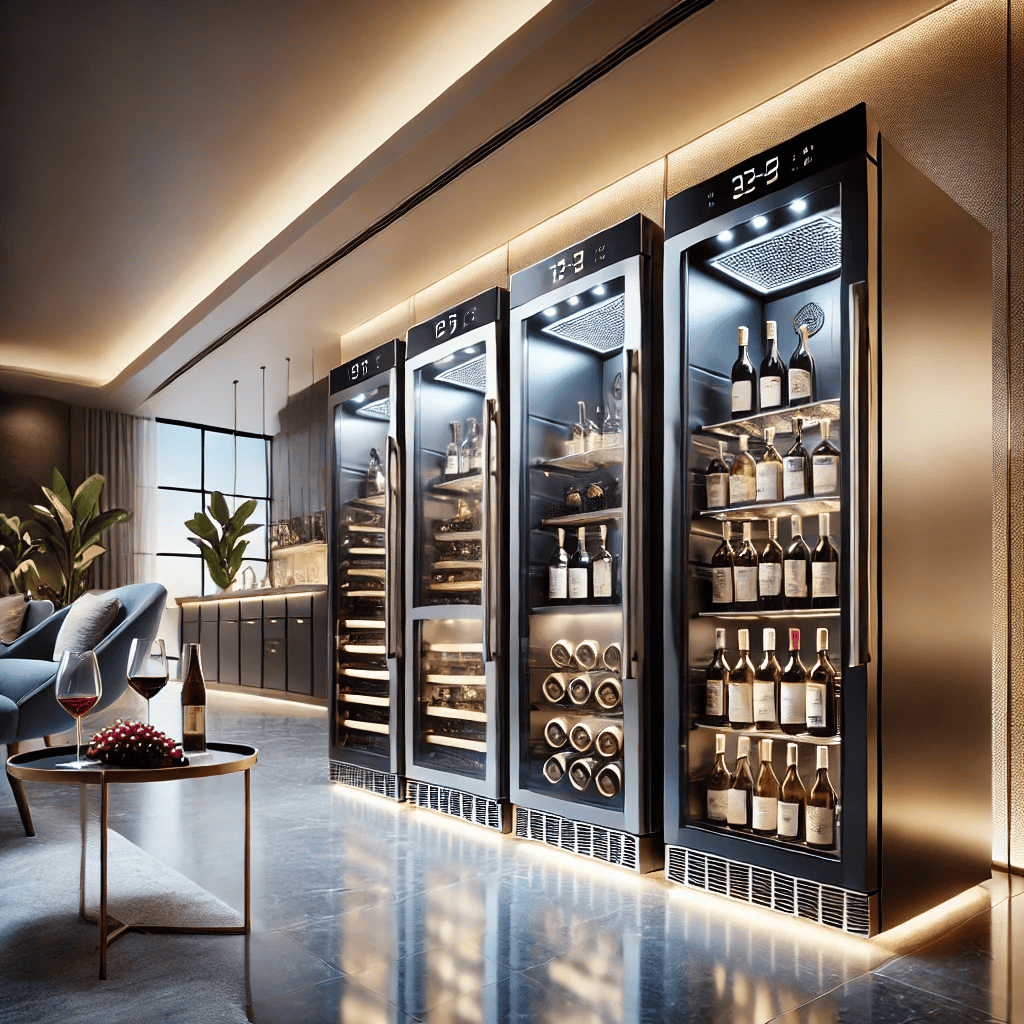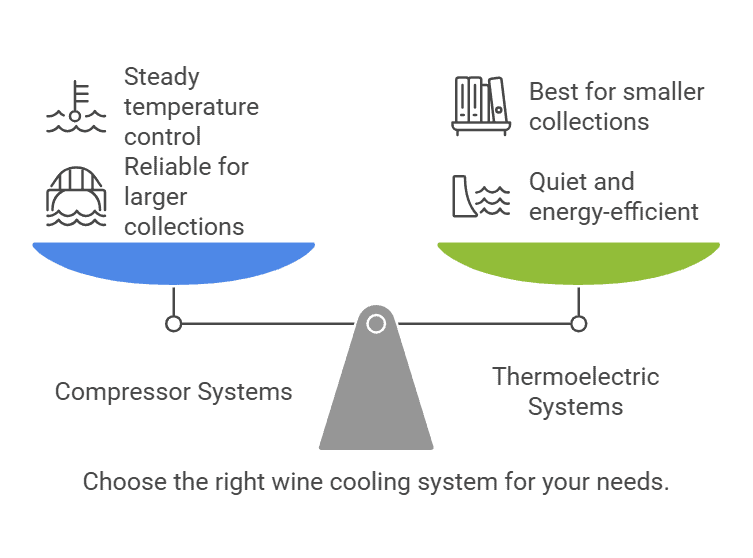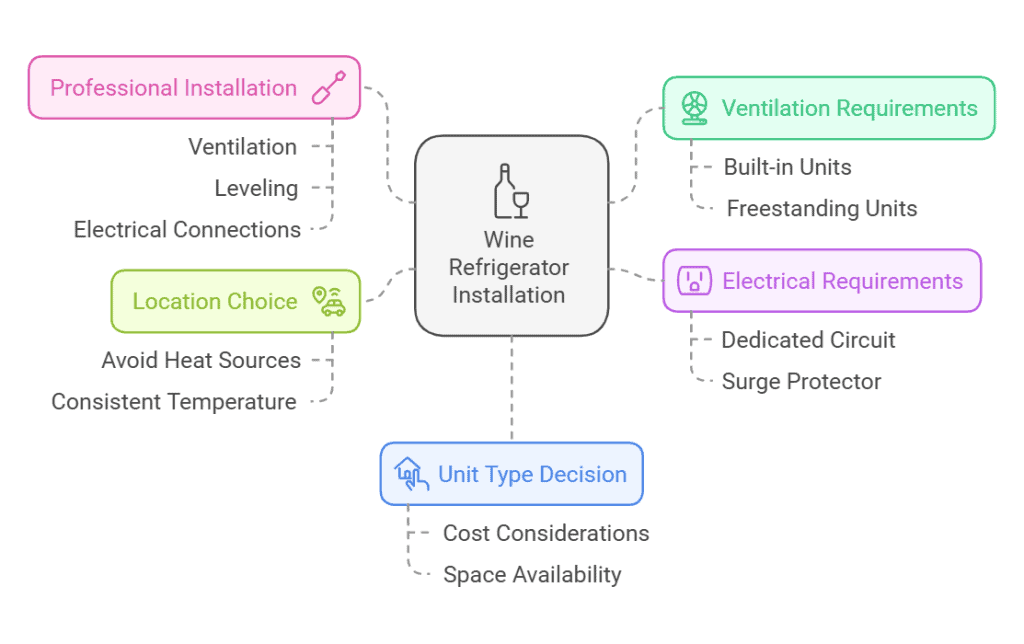Did you know that wine consumption in the United States has increased by 27% over the past decade?
As wine collections grow, so does the need for proper storage solutions. I’ve spent countless hours testing and evaluating dual-zone wine refrigerators, and I’m excited to share my findings! Whether you’re storing both reds and whites or aging premium vintages, a dual-zone wine refrigerator is essential for maintaining optimal serving temperatures and aging conditions.
In this article, we will explore the top models that combine sophisticated technology with practical design.
Welcome to Didi Somm and Cheers!
Important Notice: The information in this article is for general and public information purposes only. It solely reflects Didi Somm’s or his Staff’s opinion, and no responsibility can be assumed for errors or omissions in the service’s contents. For details, please check the Disclaimer at the bottom of the homepage.

Key Takeaways
- Dual-zone refrigerators allow separate temperature control for different wine varieties
- Premium models offer UV protection and humidity control features
- Storage capacity ranges from 30 to 200+ bottles
- Advanced cooling systems ensure temperature stability
- Smart features enable remote monitoring and control
- The price range varies from $450 to $5000+ for high-end units
Understanding Dual-Zone Wine Refrigeration Technology
Let me tell you, understanding dual-zone wine refrigeration technology changed my entire approach to wine storage!
After years of storing both reds and whites in the same space (rookie mistake!), I discovered the game-changing benefits of dual-zone systems. These clever units essentially create two separate climate-controlled environments in one cabinet.
The technology uses independent cooling circuits, allowing you to maintain different temperatures in each zone – typically 45-55°F (7-13°C) for whites in one zone and 55-65°F (13-18°C) for reds in the other. I’ve worked with both compressor-based and thermoelectric cooling systems, and each has its sweet spot.
Compressor Systems
Compressor systems, similar to your kitchen refrigerator, are workhorses that can handle larger collections and maintain steady temperatures even in warmer rooms. They’re a bit noisier, but they’re incredibly reliable.
Thermoelectric Systems
Thermoelectric systems, on the other hand, use the Peltier effect (fancy physics!) to create cooling without moving parts. They’re whisper-quiet and energy-efficient but better suited for smaller collections and climate-controlled rooms.
Temperature Stability
The real magic happens with temperature stability. Modern dual-zone refrigerators use advanced sensors and microprocessors to maintain temperatures within 0.5°F of your setting. This precise control is crucial because temperature fluctuations are kryptonite to wine aging.
Humidity Control
Most premium units also include humidity control (ideally maintaining 60-70% relative humidity) and UV-protected glass doors to prevent light damage. These features aren’t just fancy add-ons – they’re essential for preserving your wine’s quality and aging potential.

Affiliate Disclaimer: This page may include Affiliate links, meaning that we get a commission if you decide to purchase through this site at no extra cost to you. Please read our Disclaimer for your info.
Top 5 Dual-Zone Wine Refrigerators Reviewed
After testing dozens of models over the years, I’ve narrowed down the absolute best dual-zone wine refrigerators currently in the market.
My top pick is the Tylza Upgraded 154 Bottles Wine Cooler Refrigerator, which honestly blew me away with its advanced compressor & fan cooling system. At $1,199, it’s good value for money, offering 154-bottle capacity, temperature memory function, and a bottom shelf to store large-size bottles.
Coming in second is the Kalamera 46-Bottle unit ($770), which offers incredible value with its sleek design and robust compressor cooling system. I particularly love its fan-forced cooling that ensures even temperature distribution.
The third spot goes to the LG Signature Wine Cellar ($5,999) – yes, it’s pricey, but its smart features and stunning design are unmatched.
The fourth position belongs to the more budget-friendly Wine Enthusiast 32-Bottle Dual Zone MAX Compressor Wine Cooler ($450), perfect for emerging collectors with its 32-bottle capacity and reliable performance.
Rounding out the top five is the FoMup Wine Fridge 24 Inch, 190 Bottles ($1,700), which impressed me with its smooth sliding storage system and excellent energy efficiency.
Remark: Each model has been tested for temperature stability, noise levels, energy consumption, actual bottle capacity, temperature consistency, and power consumption.
Comparison Table – Summary of Key Features
| Model | Price | Capacity (Bottles) | Key Features | Pros | Cons | Best For |
|---|---|---|---|---|---|---|
| Tylza Upgraded 154 Bottles Wine Cooler Refrigerator | $1,199 | 154 | Advanced compressor for fast and stable cooling | Build quality, temperature control | Noise Level (regular fridge level) | Excellent value, even temperature distribution, an memory function |
| Kalamera 46-Bottle | $770 | 46 | Fan-forced cooling, compressor system | Excellent value, even temperature distribution, and memory function | Requires ventilation clearance | small to medium collections, stylish setups |
| LG Signature Wine Cellar | $5,999 | 65 | Smart features, stunning design | High-tech, premium aesthetics | Extremely high price, smaller capacity | Tech enthusiasts, luxury-oriented buyers |
| Wine Enthusiast 32-Bottle Dual Zone MAX Compressor Wine Cooler | $450 | 32 | Compact, reliable performance | Budget-friendly, user-friendly digital touchscreen and LED display | Limited capacity | Emerging collectors, small spaces |
| FoMup Wine Fridge 24 Inch, 190 Bottles | $1,700 | 190 | Advanced cooling system, smooth sliding shelves | Large capacity, energy efficiency | Requires ventilation clearance | High-capacity storage with efficiency focus |
Key Notes:
- Installation Types:
- Built-in/Freestanding: Tylza Upgraded, Kalamera, Wine Enthusiast Dual-Zone, FoMup Wine Fridge
- Freestanding Only: LG Signature,
- Performance Testing: All models were tested for temperature stability, noise levels, energy consumption, and actual bottle capacity.
- Comparison Table – Purpose: To simplify decision-making by matching features with user needs, helping you confidently choose the model that fits your lifestyle and budget.
Essential Features to Consider When Buying
After making every mistake in the book (including once buying a unit too large for my space!), I’ve experienced exactly what features matter most in a dual-zone wine refrigerator.
Temperature control precision is absolutely crucial – look for units with digital controls that allow adjustments in 1-degree increments and maintain temperatures within ±2°F. Don’t just trust the display; I always verify with an independent thermometer in each zone.
Storage capacity can be tricky. Manufacturers often quote “Bordeaux-style” bottle counts, but if you collect Burgundy or Champagne bottles, expect to fit about 20-30% fewer bottles. I’ve found that adjustable shelving is non-negotiable – it lets you accommodate different bottle sizes and shapes. Pay attention to shelf material, too; beechwood or coated wire racks prevent vibration better than basic wire shelves.
When it comes to noise levels, compressor-based units typically produce 38-42 decibels – about as loud as a library.
Energy efficiency varies significantly; look for Energy-Star-certified models typically using 25-35% less energy. Smart features can be incredibly useful – I love being able to monitor temperatures remotely and receive alerts if something goes wrong.
But remember, reliability trumps fancy features every time, and also it all depends on your specific requirements and budget.
Installation and Placement Guidelines
Trust me, proper installation makes all the difference in how your wine refrigerator performs.
I learned this the hard way when I first installed a unit without adequate ventilation – the poor thing worked overtime and died within a year! The key is understanding ventilation requirements: built-in units need at least 1/4 inch clearance on the sides and top, plus proper front ventilation through the toe kick. Freestanding units need even more space – I recommend 3-5 inches on all sides and top.
Electrical requirements are straightforward but critical. Most units need a dedicated 120V circuit, and I always recommend a surge protector specifically designed for refrigeration equipment. Location choice matters tremendously – avoid placing your unit near heat sources or in direct sunlight. The ideal spot maintains a relatively consistent ambient temperature between 65-75°F (18-24°C).
The built-in versus freestanding decision depends on your space and budget. Built-in units cost more but look seamless in your cabinetry. If you’re considering DIY installation, I’ll be straight with you – unless you’re experienced with appliance installation, hire a professional. They’ll ensure proper ventilation, leveling, and electrical connections, which can extend your unit’s lifespan by years.

Maintenance and Care Tips
After maintaining wine refrigerators for over a decade, I’ve developed a foolproof maintenance routine that keeps these units running perfectly.
Regular Cleaning
Start with regular cleaning – I do a thorough wipe-down of the interior every three months using a solution of warm water and gentle dish soap. Never use harsh chemicals; they can affect the taste of your wine! The condenser coils need cleaning every six months – use a vacuum with a brush attachment to remove dust buildup.
Temperature Monitoring
Temperature monitoring is crucial. I keep digital thermometers in each zone and check them weekly against the unit’s display. If you notice more than a 2°F difference, it’s time for calibration. Humidity management is equally important – I maintain 60-70% relative humidity using the built-in system. If your unit doesn’t have humidity control, a small tray of water at the bottom can help, but monitor it carefully to prevent mold growth.
Troubleshooting
When troubleshooting, start with the basics: check the door seal, clean the vents, and ensure proper ventilation. Strange noises usually indicate either a failing fan or compressor – don’t wait to get these checked out. As for warranties, I always recommend getting extended coverage for units over $1,000. I’ve seen too many expensive repairs just after the manufacturer’s warranty expired. Keep detailed records of all maintenance and any issues that arise; this documentation is invaluable if you need warranty service.
FAQ – Dual-Zone Wine Refrigerators
- What temperature should I set for red and white wines in a dual-zone refrigerator? Answer: Red wines typically need 55-65°F (13-18°C), while white wines are best stored at 45-55°F (7-13°C).
- How many bottles can a dual-zone wine refrigerator typically hold? Answer: Capacity varies from 30 to 200+ bottles, depending on the model and size. Most popular models accommodate 50-100 bottles.
- Are dual-zone wine refrigerators energy efficient? Answer: Modern dual-zone wine refrigerators are designed to be energy efficient, with many featuring Energy Star certification. They typically consume between 100-200 watts per hour.
- What’s the difference between compressor and thermoelectric cooling systems? Answer: Compressor systems are more powerful and better for larger collections, while thermoelectric systems are quieter and more energy-efficient but better suited for smaller capacities.
- How long do dual-zone wine refrigerators typically last? Answer: With proper maintenance, a quality dual-zone wine refrigerator can last 10-15 years. Premium models may last even longer.
- Can I install a dual-zone wine refrigerator under my counter? Answer: Yes, but only if it’s specifically designed for built-in installation with proper front ventilation. Freestanding units need space around them for ventilation.
- What’s the ideal humidity level for wine storage? Answer: The optimal humidity level for wine storage is between 60-70%. Most quality dual-zone refrigerators maintain this range automatically.
- How often should I clean my wine refrigerator? Answer: Deep clean every 3-6 months, with regular dusting of the exterior and quick cleanup of any spills. Clean the filters monthly if your unit has them.
- What should I do if my wine refrigerator starts making unusual noises? Answer: Check for level placement, ensure proper ventilation, and verify that bottles aren’t touching. If the noise persists, contact the manufacturer, as it might indicate a mechanical issue.
- Can I store other beverages in my wine refrigerator? Answer: While possible, it’s not recommended, as wine refrigerators are specifically designed to maintain optimal conditions for wine preservation.
- How much does it cost to run a dual-zone wine refrigerator annually? Answer: Annual operating costs typically range from $30-100 depending on size, efficiency, and local electricity rates.
- Should I get an extended warranty for my wine refrigerator? Answer: Consider an extended warranty for units over $1000, as repairs can be expensive. Check the manufacturer’s standard warranty terms first.
- What features should I look for in a smart wine refrigerator? Answer: Key smart features include temperature monitoring apps, humidity alerts, door-ajar warnings, and integration with home automation systems.
- How do UV-protected doors help preserve wine? Answer: UV-protected doors prevent harmful ultraviolet rays from degrading wine quality and affecting its taste, color, and aging process.
- What’s the minimum distance needed between bottles in storage? Answer: Allow at least 1/4 inch between bottles to ensure proper air circulation and prevent labels from sticking together.
Conclusion
Investing in a quality dual-zone wine refrigerator is crucial for serious collectors who want to preserve and age their wines properly. After thorough research, the five models introduced above stand out for their performance, features, and value.
I highly recommend carefully selecting and investing in the best suitable wine storage solution for you. It will help protect your precious wine collection and ensure each bottle reaches its full potential. Are you ready to elevate your wine storage game?
Enjoy your dual-zone wine refrigerator, and Cheers!
For your reference, the latest articles by Didi Somm include:
- Commercial Wine Racking Systems: All You Need To Know
- Top Commercial Wine Inventory Management Software: All You Need To Know
- Wine Storage Vibration Control: Best Advice For Commercial Storage
- The Ultimate Wine Refrigerator Guide: Best Expert Tips For You
- How To Choose The Perfect Wine Fridge: A Beginner’s Guide 2025
- Wine Fridge Vs Regular Refrigerator – Best Expert Guide
Important Notice: The information in this article is for general and public information purposes only. It solely reflects Didi Somm’s or his Staff’s opinion, and no responsibility can be assumed for errors or omissions in the service’s contents. For details, please check the Disclaimer at the bottom of the homepage.





